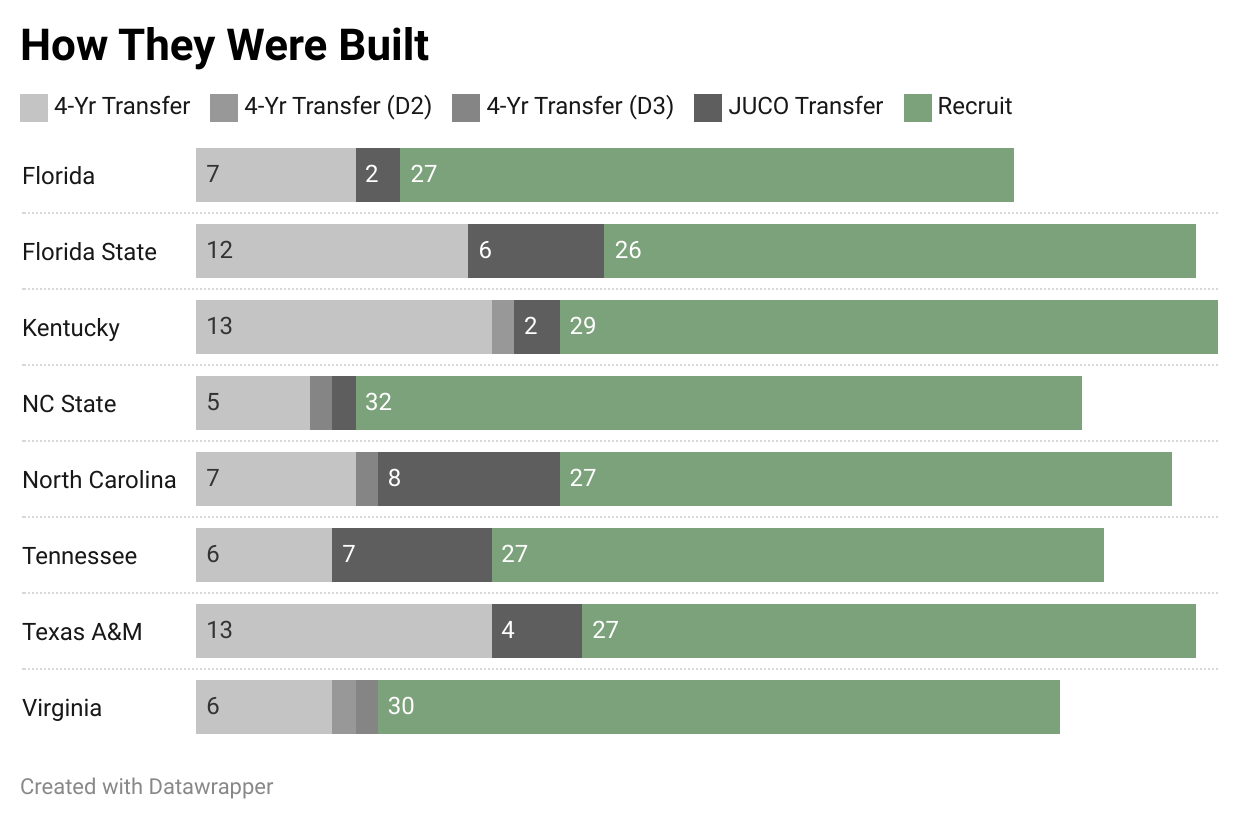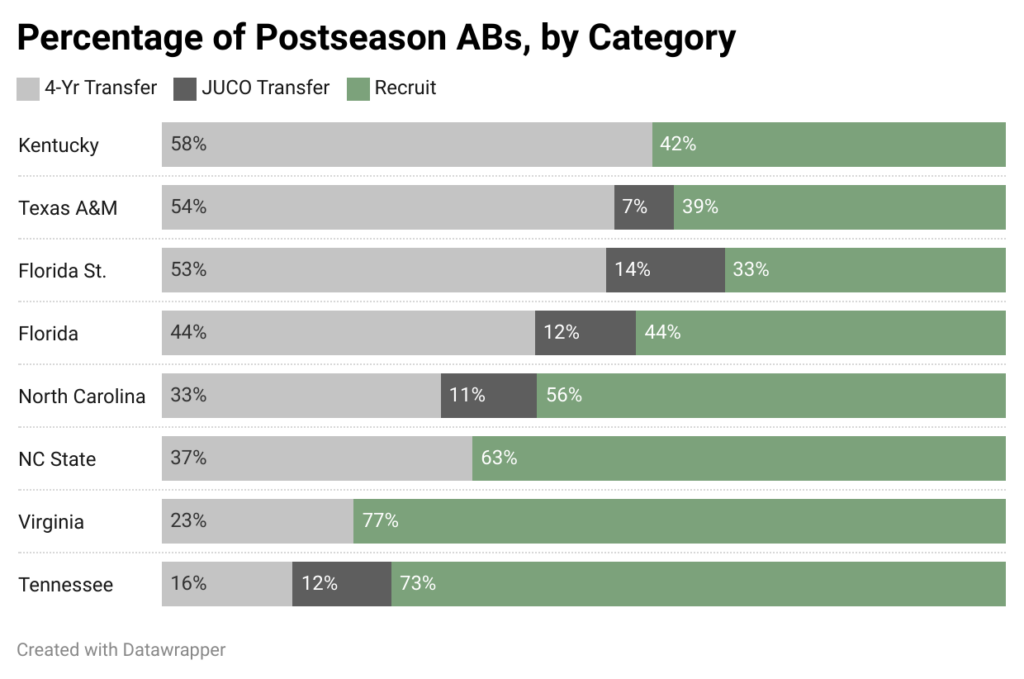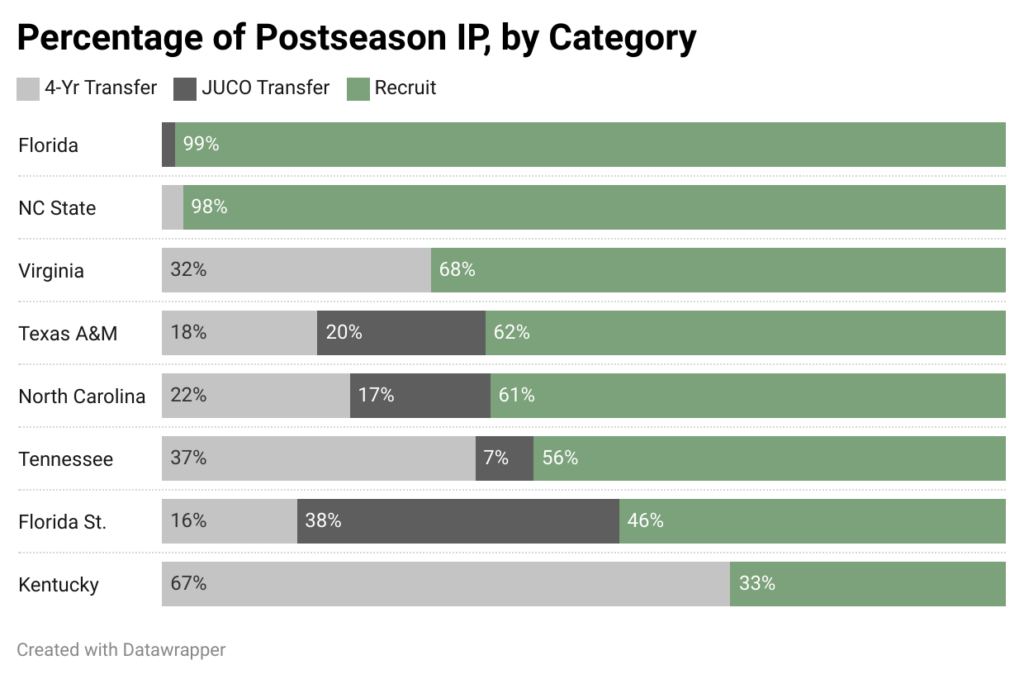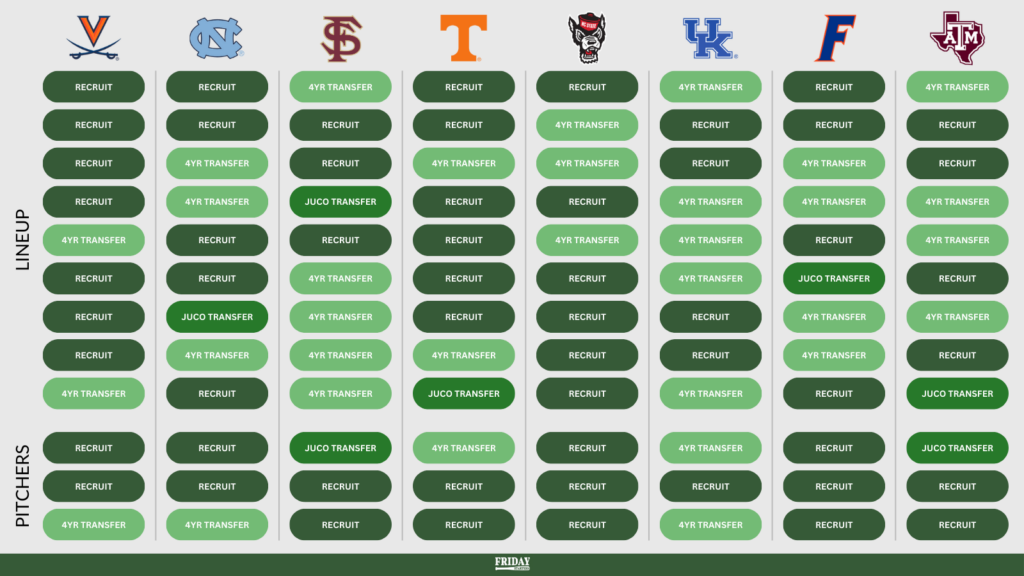Editor’s Note: A previous version of this article incorrectly categorized NC State’s Garrett Pennington as a JUCO transfer. Pennington started his career at D-II Central Missouri before moving to D-I Wichita State and then to the Wolfpack. All charts have been updated.
College baseball — and sports, in general — has had quite the few years of upheaval. Whether it’s the introduction of NIL, the roster crunch brought on by COVID, or the ability to freely transfer without penalty, we’ve seen unprecedented levels of roster shuffling. With that in mind, it felt useful to take a look at how the College World Series teams were built in this era of roster turnover.
To do so, we’ll be taking a look at the general roster construction alongside more specifics from the postseason — like where are the at bats and innings came from and how additions (or subtractions) panned out.
Below is a detailed look at each roster (per their official website), broken down by where the player came from. Here are the categories:
- Recruit — Has been on campus since arriving as a freshman.
- 4-Yr Transfer — Transferred in from another Division I school.
- 4-Yr Transfer (D2), 4-Yr Transfer (D3) — Transferred from a lower division.
- JUCO Transfer — Transferred in from a junior college.

The bulk of rosters, as you’d expect, are still made up of original recruits. NC State, Virginia, and Florida stand out with fewer transfers — whether D1, D2, D3, or JUCO — while schools like Texas A&M, Florida State, and Kentucky have double-digit additions. It’s more useful to look at the postseason results through the first two rounds, though, to get a sense of what the breakdown is amongst players that are getting meaningful at bats and innings.
Back in 2022, when Baseball America took a look at this, three schools (Stanford, Notre Dame, and Ole Miss) gave ~90% of their postseason at bats to what we’re classifying as original recruits. This season, zero teams meet that threshold. This chart looks at percentage of postseason at bats by player origin.

In terms of transfers, Florida State has the highest total percentage of postseason at bats (JUCO plus 4-year). While the heart of the lineup — Cam Smith, James Tibbs III, and Jaime Ferrer — are original recruits, the rest of the group comes from a variety of places. Leadoff hitter Max Williams (Alabama), clean-up hitter Marco Dinges (Tallahassee CC), and six-through-nine in the lineup (USF, North Florida, UCF, and Alabama) were all transfer additions.
Kentucky and Texas A&M are right there with the Seminoles. Leadoff hitter Ryan Waldschmidt came from Charleston Southern prior to last year, while Mitchell Daly (Texas), Nick Lopez (USC), and Ryan Nicholson (Cincinnati) form the four-through-six spots. The Aggies, meanwhile, made the biggest splash with Braden Montgomery (Stanford) but also feature Jackson Appel (Penn), Hayden Schott (Columbia), Ted Burton (Michigan), and Ali Camarillo (CSUN) in the lineup.
On the other side of the spectrum, Virginia and Tennessee stand out with a core of players they’ve developed into lineup regulars. Virginia gave nearly 80 percent of at bats to that category, supplementing with two additions: D3 transfer Jacob Ference (Salisbury) and Bobby Whalen (Indiana). The Volunteers have a core of “homegrown” stars as well, but supplemented with a major addition in Billy Amick (Clemson) alongside Dalton Bargo (Missouri).
Now, on to pitching. Here’s the same chart, but looking at percentage of postseason innings.

Florida and NC State stand out in terms of so-called homegrown pitching development. The Gators have used 15 different pitchers this postseason and just one was not an original recruit, going the JUCO route. The bulk of the innings have been handled by the likes of Brandon Neely (16 IP), Jac Caglianone (10.2 IP), and Fisher Jameson (9.2 IP). All three are in their third year in Gainesville. The Wolfpack leaned on two veterans — Sam Highfill and Logan Whitaker — to get here while youth has paid off with Jacob Dudan, Dominic Fritton, and Derrick Smith.
Florida State has the highest share of junior college innings thanks to the key addition of Carson Dorsey out of Gulf Coast State College. Kentucky has leaned on four-year transfers the most, accounting for two-thirds of innings pitched this postseason. The Wildcats picked up College of Charleston’s Trey Pooser and Central Connecticut State’s Dom Niman for the rotation while giving meaningful relief innings to Campbell’s Cameron O’Brien and Texas A&M’s Robert Hogan.
Finally, here’s a look at each team’s most recent lineup along with the top three pitchers by innings pitched this NCAA Tournament.

Featured Images via Gulf Coast CC, Clemson Athletics, and Cinncinnati Athletics

